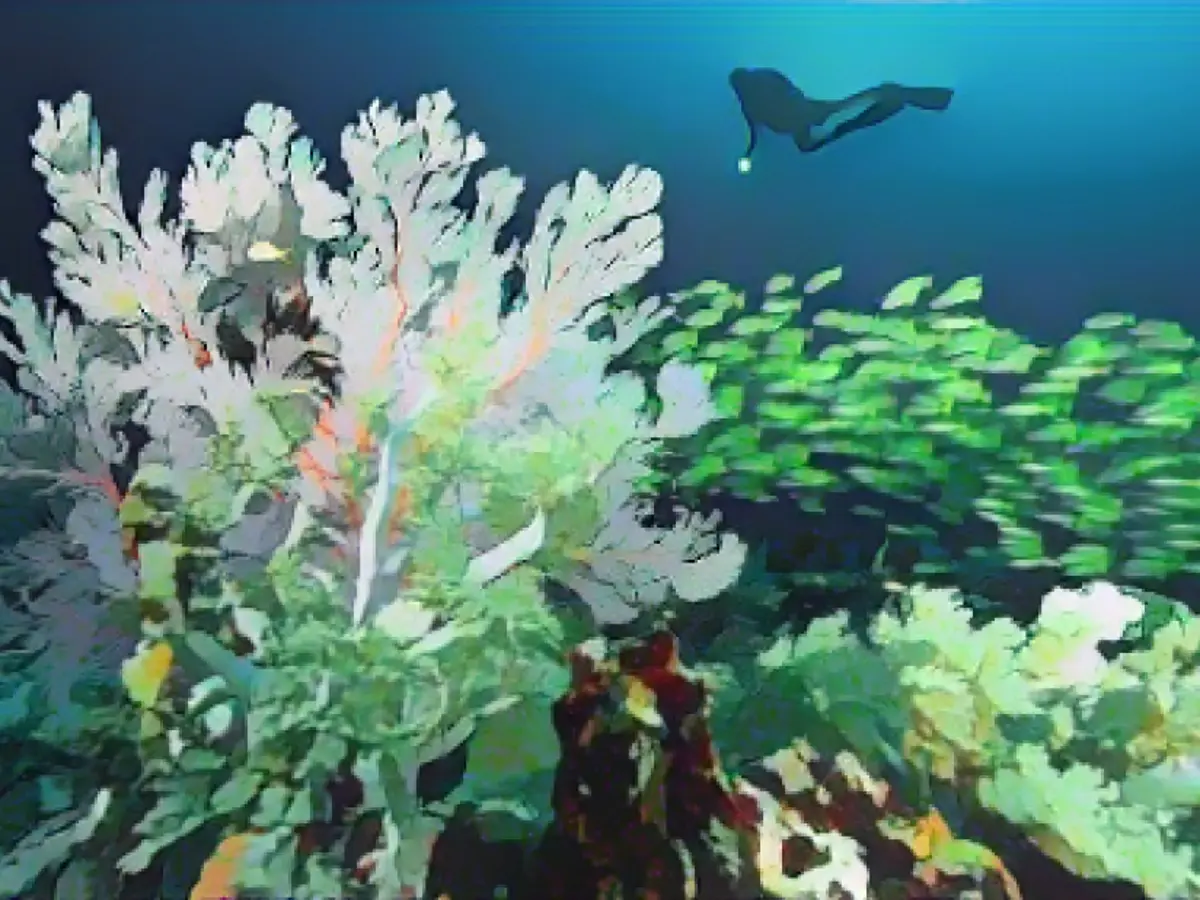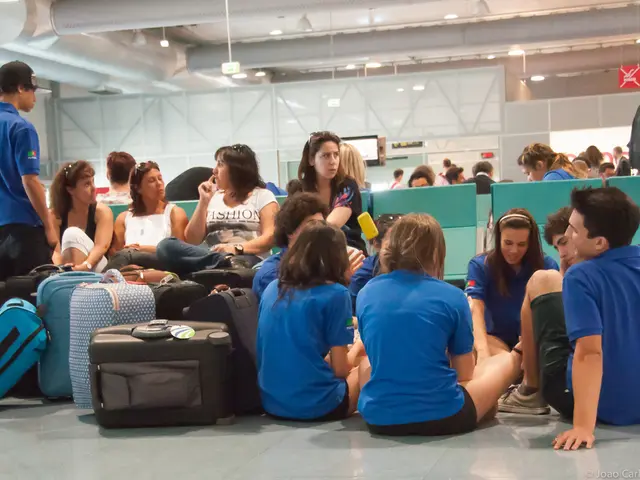Exploring the Biodiverse Wonders of Raja Ampat: Indonesia's Last Paradise on Earth
On a four-month diving expedition, Armor consulted with local fishermen in Raja Ampat, a remote archipelago in West Papua, Indonesia. This region, often praised as "the last paradise on Earth," is renowned for its unparalleled marine biodiversity.
With over four million hectares and approximately 1,500 islands, Raja Ampat Marine Reserve Network is nestled in the heart of the Coral Triangle. The area boasts an astonishing array of 1,600 fish species and provides habitat for 75% of the world's known coral species[1].
Amazed by its beauty, Armor decided to open Kri Eco-Diving Resort in 1994 to train local divers and introduce visitors to this pristine underwater world. This was followed by another resort in Solido Bay, managed by Papua Diving in the US[2].
Raja Ampat's Marine Biodiversity: A Precious Gem Under Threat
Raja Ampat was once in decline due to unregulated commercial fishing and unsustainable harvesting practices, such as shark finning and sea turtle poaching. However, a combination of local and international efforts turned Raja Ampat's fate around.
In 2004, Raja Ampat became part of the Birds Head Seascape Initiative, a project aimed at creating a network of marine protected areas in collaboration with international conservation organizations and local authorities. The initiative focused on preserving marine resources while ensuring sustainable livelihood opportunities[3].
Resilience and Local Engagement Key to Protecting Raja Ampat's Rich Biodiversity
The key to protecting Raja Ampat lies in creating awareness and encouraging local communities to become active participants in its conservation. By employing local residents to monitor and safeguard these protected areas, indigenous knowledge, values, and traditional practices like "Sasi" are preserved[4].
Community-centered conservation projects have resulted in a resurgence of fish stocks, a significant decrease in poaching by external fishers (down by approximately 90%), and the recovery of coral reefs. Long-term food security and income opportunities for the local community have also improved as a result[4].
The Misool Eco-Resort: A Success Story of Sustainable Tourism
Marit Miners, co-founder of the renowned Misool Eco-Resort and Misool Foundation, highlights the importance of involving local communities in sustainable projects. Sonja and her husband Andrew, inspired to save Raja Ampat's marine resources after visiting the region in 2005, established the Misool Foundation and Misool Resort to support conservation efforts.
In 2007, Misool transformed a former shark finning camp into a "No-Take-Zone," prohibiting any fishing or hunting activities within the 300,000-hectare area. Ranger patrols of the local community were hired to ensure the protection and preservation of the marine ecosystem[5].
The Resort's commitment to sustainability is reflected in various initiatives, from energy-saving solar panels to replacing single-use plastics with bio-degradable alternatives. Guests can also participate in coral restoration projects and contribute to the protection of these pristine marine environments[5].
However, the true testament to Raja Ampat's successful conservation efforts lies in the improvement in marine health—refugees of sea turtle poaching and once-deserted "white sand beaches" teeming with dead shark fins are now restored to their former glory[2].
With the help of dedicated conservationists, marine researchers, communities, and businesses, Raja Ampat's rich marine ecosystem has shown promising signs of recovery, spurring hope for its continued growth and preservation [4][6].
Related articles:
Rewritten Paragraphs and Sentence Structure
Upon embarking on a four-month diving expedition in Raja Ampat, Armor discovered an awe-inspiring location amid the archipelago. Known as one of the most biodiverse marine environments on Earth, the area offered an abundance of stunning coral reefs and a hotspot for diverse marine species.
In 1994, Armor opened the Kri Eco-Diving Resort to empower local divers and showcase the captivating underwater landscapes that drew so many visitors from around the world. Almost a decade later, a new resort in Solido Bay was built and managed by Papua Diving, fostering an ongoing commitment to localized sustainability in Raja Ampat.
Raja Ampat was once in decline due to unsustainable fishing practices and lack of governmental oversight. However, ambitious conservation projects and neighborhood revitalization efforts aimed at fostering local skills and tapping into existing community knowledge revived this iconic marine ecosystem.
The Birds Head Seascape Initiative, initiated in 2004, emphasized the connection between marine resources protection, food security, and sustainable economic growth for the local population. Collaboration between international conservation organizations and local authorities transformed the region's status, with fish populations gradually recovering, illegal fishing activities significantly decreasing, and coral reefs enjoying a revitalization[3].
Bridging the gap between cultural heritage, environmental stewardship, and modern conservation initiatives has paved the road for the successful preservation of Raja Ampat's precious marine resources.
The Misool Eco-Resort proposal, led by Marit Miners, highlights the importance of engaging with the local community in sustainable initiatives. In a loving tribute to the past and a commitment to the future, New Zealand natives Marit and Andrew established the Misool Foundation in 2005. Together, they transformed a former haifinnische Kalksteinbasis in ein No-Take-Zone, mit Verbot aller Fischerei und Jagdaktivitäten in diesem 300,000 Hektar großen Gebiet[5].
Since 2007, the local community has been employed as ranger patrols to safeguard the dazzling marine life within the reserved area. Sustainable tourism is evident in various practices at the resort, such as solar panel energy efficiency, biodegradable materials replacing single-use plastics, and coral restoration projects that allow guests to contribute to preserving these beautiful marine habitats[5].
Enrichment Data
Undeniably, the biodiverse wonders of Raja Ampat, Indonesia's last pristine marine haven, face substantial challenges. Most prominent among these is coral bleaching and an unwelcome intruder: cyanobacteria. Although these threats persist, diverse initiatives aimed at conservation, restoration, education, and community engagement are making a difference.
- Reef Health Monitoring and Conservation: Tourists and operators like Ocean Eye actively participate in recording marine animal sightings. Relevant donations support habitat preservation, providing ongoing education for coastal communities and promoting sustainable tourism practice[1].
- Scientific Research and Monitoring: Researchers such as Dr. Erika Gress and Dr. Josie Chandler closely monitor cyanobacteria blooms around Arborek Island, informing the government and the Raja Ampat Marine Parks Authority about the urgent need for mitigation efforts[2].
- Wastewater Treatment Systems: Proposing bio tanks and wastewater treatment systems that use microorganisms to break down sewage residues is crucial to minimize the impact of untreated wastewater on coral reefs. However, low geography and tidal factors complicate their installation in Raja Ampat[2].
- Sustainable Tourism Practices: Initiatives such as the Child Aid Papua project foster education about marine conservation among students in Raja Ampat. Such programs aim to promote balance in marine ecosystems and enhance their resilience to stressors through collaboration and education[1][5].
Despite these notable efforts, the recovery of Raja Ampat's deteriorating marine ecosystem is not without challenges. Cyanobacteria blooms and climate change are exacerbating the impacts of coral bleaching, jeopardizing the region's resilience and marine biodiversity. Addressing these challenges requires collective action and ongoing commitment to sustainable development, conservation, and education in the region.
Sources:
*Raja Ampat, Indonesia's "Last Paradise on Earth," is facing significant threats to its marine biodiversity, including coral bleaching and the proliferation of cyanobacteria. Source: *
*As coral reefs struggle with cyanobacteria blooms, the Indonesian government and the Raja Ampat Marine Parks Authority (BLUD) have appointed researchers like Dr. Erika Gress and Dr. Josie Chandler to monitor the situation and take immediate action, ensuring the health and survival of the region's unique marine ecosystem[2]. Source: *
*Raja Ampat was once plagued by illegal fishing and unsustainable harvesting practices. However, ambitious conservation projects in collaboration with international conservation organizations and local authorities have dramatically transformed the area[3]. Source: *
*Successfully reviving marine ecosystems in Raja Ampat requires the support and participation of local communities, ensuring their long-term food security and economic growth in parallel with the conservation efforts. Source: *
*The community-centric Misool Eco-Resort, established by Marit Miners and her husband Andrew, stresses the importance of collaborative conservation efforts with the local community by offering ranger patrolling opportunities, catering meals from a lush garden, implementing recycling and nutrient management programs, and donating potable water systems. Source: *







